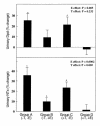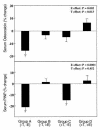Relative contributions of testosterone and estrogen in regulating bone resorption and formation in normal elderly men
- PMID: 11120762
- PMCID: PMC381474
- DOI: 10.1172/JCI10942
Relative contributions of testosterone and estrogen in regulating bone resorption and formation in normal elderly men
Abstract
Young adult males who cannot produce or respond to estrogen (E) are osteopenic, suggesting that E may regulate bone turnover in men, as well as in women. Both bioavailable E and testosterone (T) decrease substantially in aging men, but it is unclear which deficiency is the more important factor contributing to the increased bone resorption and impaired bone formation that leads to their bone loss. Thus, we addressed this issue directly by eliminating endogenous T and E production in 59 elderly men (mean age 68 years), studying them first under conditions of physiologic T and E replacement and then assessing the impact on bone turnover of withdrawing both T and E, withdrawing only T, or only E, or continuing both. Bone resorption markers increased significantly in the absence of both hormones and were unchanged in men receiving both hormones. By two-factor ANOVA, E played the major role in preventing the increase in the bone resorption markers, whereas T had no significant effect. By contrast, serum osteocalcin, a bone formation marker, decreased in the absence of both hormones, and both E and T maintained osteocalcin levels. We conclude that in aging men, E is the dominant sex steroid regulating bone resorption, whereas both E and T are important in maintaining bone formation.
Figures



References
-
- Smith EP, et al. Estrogen resistance caused by a mutation in the estrogen-receptor gene in a man. N Engl J Med. 1994;331:1056–1061. - PubMed
-
- Morishima A, Grumbach MM, Simpson ER, Fisher C, Qin K. Aromatase deficiency in male and female siblings caused by a novel mutation and the physiological role of estrogens. J Clin Endocrinol Metab. 1995;80:3689–3698. - PubMed
-
- Carani C, et al. Effect of testosterone and estradiol in a man with aromatase deficiency. N Engl J Med. 1997;337:91–95. - PubMed
-
- Bilezikian JP, Morishima A, Bell J, Grumbach MM. Increased bone mass as a result of estrogen therapy in a man with aromatase deficiency. N Engl J Med. 1998;339:599–603. - PubMed
-
- Rochira V, Faustini-Fustini M, Balestrieri A, Carani C. Estrogen replacement therapy in a man with congenital aromatase deficiency: effects of different doses of transdermal estradiol on bone mineral density and hormonal parameters. J Clin Endocrinol Metab. 2000;85:1841–1845. - PubMed

